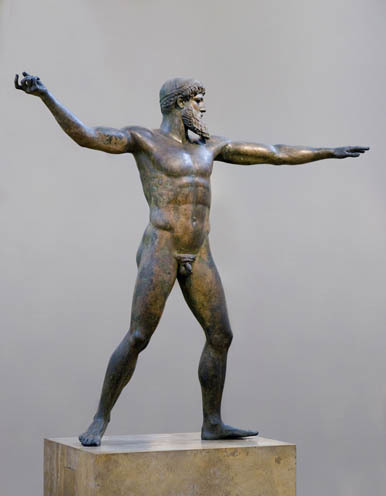Zeus of Artemision
Dublin Core
Title
Zeus of Artemision
Subject
Thought to represent the mightiest of the Olympian gods, Zeus, this statue would have been created for the delight of not only Greek citizens, but also the gods. This statue was probably created as a votive for a temple dedicated to Zeus. In presenting such works as offerings, the Greeks attempted to appease their gods, earning divine assistance or favor in return. The sculpture, which presents its subject as superhuman rather than suprahuman, is in keeping with the Greek conception of gods as immortal and immensely powerful, yet subject to the personality flaws and unpredictable emotions of mortal beings.
Description
This monumental bronze sculpture was found in two pieces at the bottom of the sea off the Cape of Artemision in the 1920s. Zeus is shown in full heroic nudity with his left arm and foot thrust dynamically forward in the direction of his foes, while his right leg and arm are raised and slightly bent, implying movement. Zeus is the militant protector ready for action and would have originally been holding a thunderbolt (or trident, in the case of Poseidon).
Creator
Unknown artist (Greece)
Source
Boardman, John. Greek Sculpture: The Classical Period, A Handbook. London: Thames & Hudson, 1985.
Publisher
Courtesy of Vanni / Art Resource, NY
Date
460 BCE
Format
Made of bronze. Approximately 7 ft. tall
Type
Religious nature
Coverage
This resource is relevant under the topic of how art functions as an instrument for religious purposes, such as praising of a specific culture's god, and highlights the difference in the artwork utilized between cultures for the sake of religious praise.
Citation
Unknown artist (Greece), “Zeus of Artemision,” Class Projects, accessed May 18, 2024, https://davidsquires.org/omeka/items/show/52.

